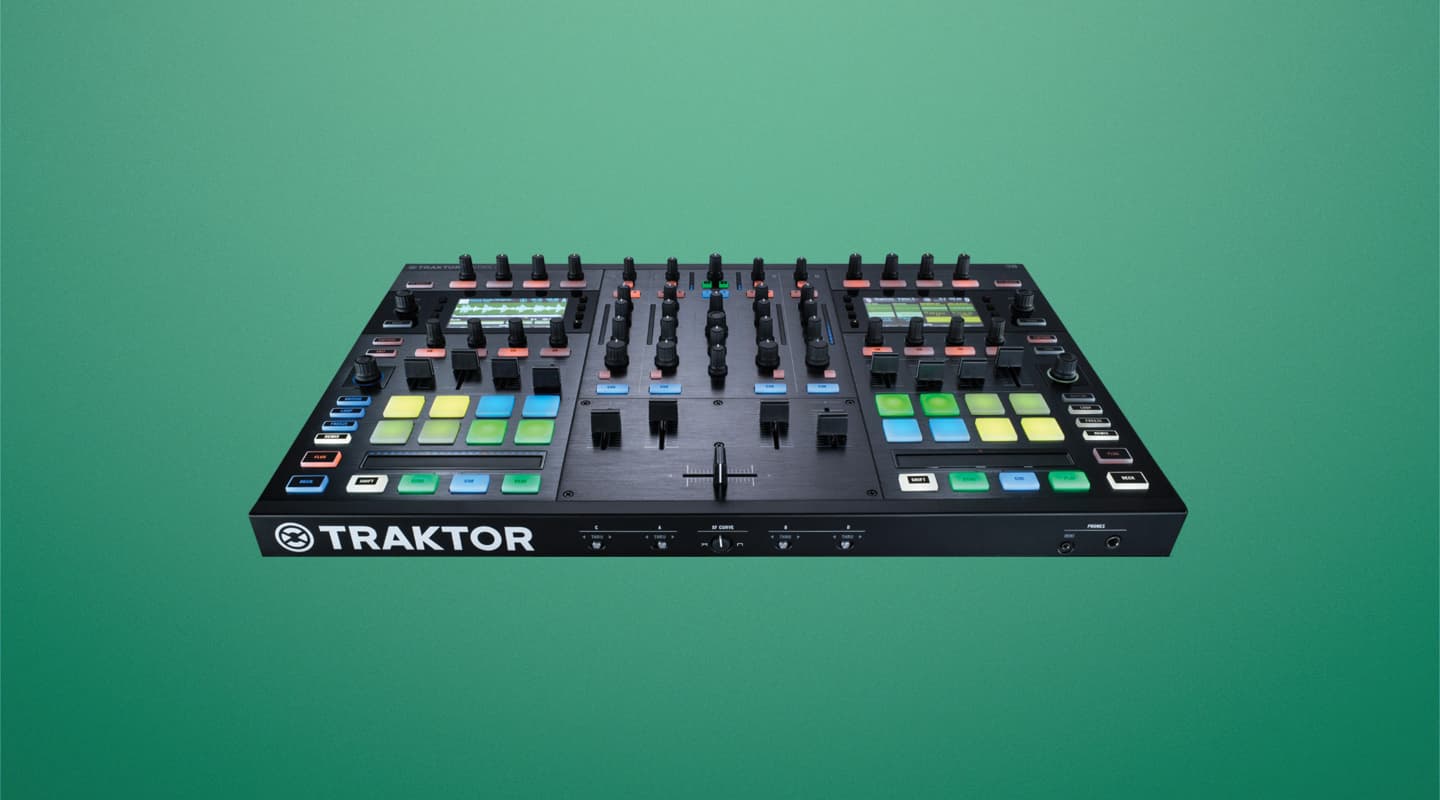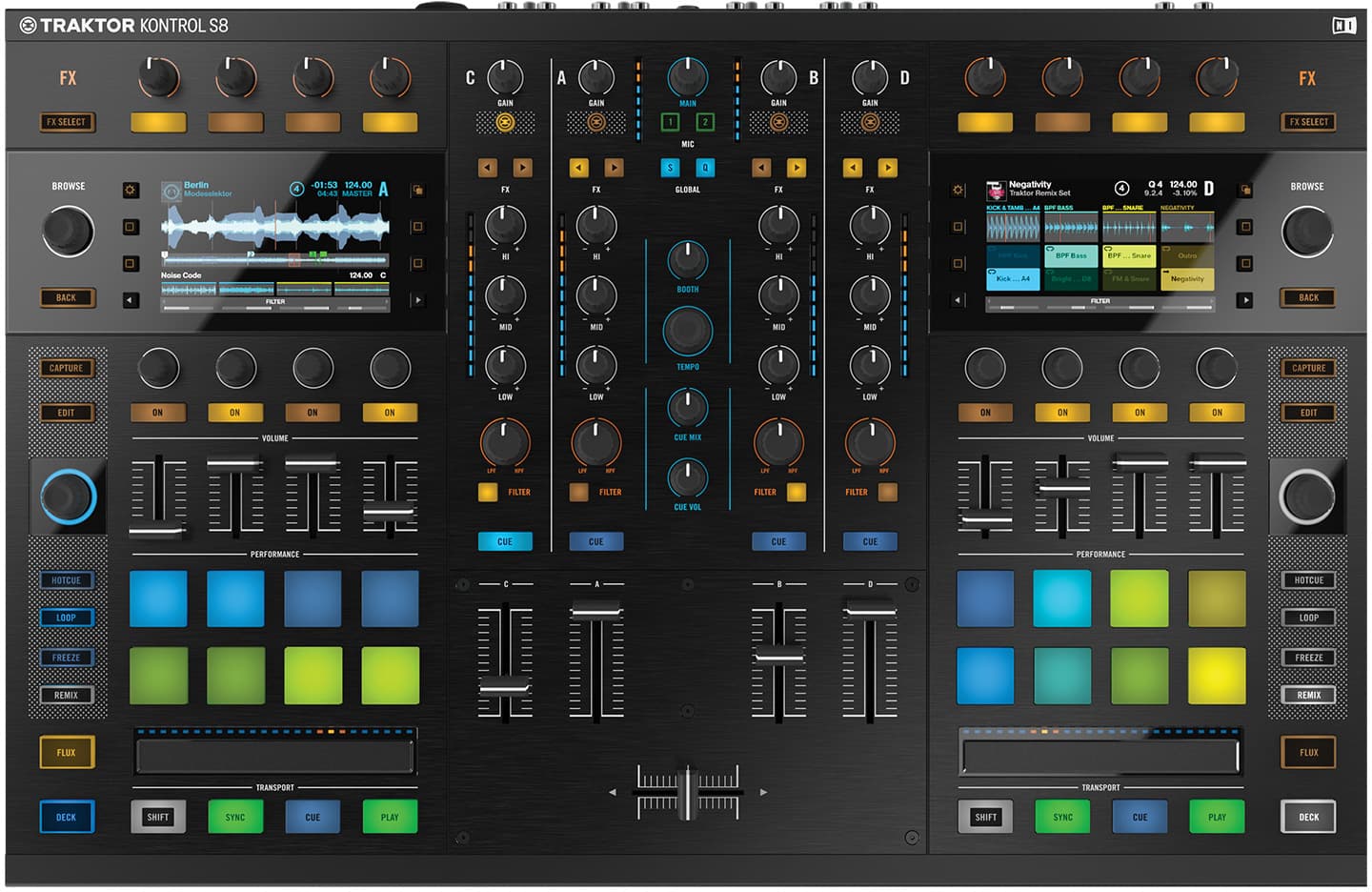
Review: Traktor Kontrol S8 Flagship DJ System
Native Instruments has been adding displays to its flagship controllers, so what can it do for the DJ crowd? AT takes the new S8 for a jog wheel-less spin.
I was pretty excited about the prospect of digging into Native Instruments’ new Traktor S8 DJ controller. A Traktor veteran of seven years, I’ve enjoyed the software’s innovation and endured its growing pains. I’m still a total fan boy who frequently gigs with the S4 Mk2 DJ system and Z2 mixer exclusively, and wouldn’t DJ with anything else. I’ve been salivating over the S8’s built-in full-colour displays — a first for the Traktor line — and the prospect of relegating my laptop from centre-stage.
DISPLAYING ITS POWER
My first impression when unboxing the S8 was that it’s stunning — in terms of footprint (substantially larger than the S4 Mk2), sheer mass and premium build quality. There are no wobbly pots or faders on this controller!
After integrating the S8 into my setup, there were some immediate indicators of where it sits in NI’s road map. The audio setup options share similar attributes with the Traktor Kontrol Z2 in that the sample rate is locked at 48k operation. Just like Z2, the S8 comes with a full Traktor Scratch Pro license allowing timecode vinyl/CD control (DVS) out of the box. By comparison, the S4 series requires a paid license upgrade for DVS control privileges. The S8 can also operate as a standalone mixer like the Z2, however, sans-FX.
In many ways, the S8 is a four-channel successor to the two-channel Z2, but with massively enhanced control of cues, looping, browsing and more, thanks to the visual feedback offered by the pair of displays; which appear identical to the ones on the flagship Maschine Studio controller — a good thing.
Track ‘preparation’ in Traktor — setting the origin point of the beat grid, ensuring the track tempo is accurate, and strategic placement of Hotcues — is a process which had required users to cosy up with their laptop. Now, with the S8’s dedicated Preparation mode for its dual displays, you can break away from the big screen. The workflow will be familiar to those who’ve used the iOS version of Traktor, Traktor DJ. In fact, the overall GUI design for the S8 screens borrows a lot from Traktor DJ.
The FX control section has been reimagined to make use of the displays too. It now not only offers an intuitive means for selecting effects — press the FX Select button and the FX names are listed in the display to scroll through and select — but also displays the name of the parameter associated with the knob you’re currently touching. Taking the guess-work out of parameter control is sure to inspire more risqué use of Traktor’s FX section. As I’m certain many casual Traktor users just leave their die-hard favourite FX loaded into slots one and two.
NEED TO KNOW
JOG WHEELS TAKE A WALK
Novation’s Twitch holds the crown as the first manufacturer brave enough to abandon any semblance of a jog wheel, substituting a touch-strip in its place. For those playing perfectly on-the-grid music genres, their absence may even be celebrated. But for DJs preferring to rock ‘commando’ — manually beat matching and riding the pitch fader on music not recorded to a click — the absence of jog wheels on the S8 wasn’t welcome news.
So what do I most miss about jogwheels? It’s not ‘scratching’, since real vinyl or DVS control via turntables reigns supreme for scratching. It’s the ergonomics of being able to reach out and touch a deck’s jog wheel to momentarily pause playback while holding it. On controllers with jog wheels, not only is this immediate and intuitive but also, thanks to the relative size of a jog wheel, compared to a play button, hard to miss!
The touch-strips on the S8 operate in a totally different fashion; upon finger contact you’re momentarily pitch bending the deck, while playback continues unimpeded. While the S8’s touch-strips offer greater sensitivity compared to Kontrol X1 Mk2 (NI’s first controller to feature touch-strips), those DJs with jog wheel muscle-memory will find the S8’s Play/Pause toggle button is going to get a big workout.
For those willing to give touch-strips a go, if you press and hold the Shift key, the S8’s touch-strips mimic the Pioneer CDJ’s needle-drop functionality for rapid seeking through a track. Used in conjunction with the track overview display above it, rapidly locating anywhere in a track becomes child’s play. This is where a touch-strip trumps the sequential nature of jog wheels.
When playback is disengaged, the touch-strip behaviour is similar to pulling vinyl back and forth on a Technics SL-1200 while powered off. The touch-strips in this mode have near-authentic acceleration/deceleration characteristics — I found this effective for track preparation sessions allowing accurate placement of beat grid origin points (similar to rocking tape over the heads of a tape machine) and setting hot cue points.
There are a few ways of changing the playback tempo of a track from the S8 hardware: hitting the first display button (below brightness) and adjusting the bpm with the Browse knob; syncing it to another tune playing; using the pitch reset function; or syncing it to Traktor’s master clock and then adjusting tempo using the dedicated Master Tempo encoder (hold Shift for finer adjustment).
With the S8’s current touch-strip behavior, the absence of jog wheels makes playing tunes you haven’t properly prepared in advance very much a hands-off affair — it feels like driving a car with a dash-mounted push button for a brake pedal. If you’re going to rock an S8 with any kind of finesse at a gig you must invest the time in track preparation prior to prime-time. Unless… you add turntables, and talent.
If you really want jog wheels, just go one step better and plug a pair of 1200s or CDJ players loaded with timecode media and any qualm over missing jog wheels will vanish! Many DJs would be aware of the Advanced HID control mode found on the near ubiquitous ‘pair of CDJ2000s’ rig in most club DJ booths. This same pair of CDJs could be pressed into service for the travelling S8 performer.
With fluid access to virtually every element within Traktor, for the professional user seeking the ultimate DVS rig, S8 would be top of the shopping list


DECKS REMIXED
Right below the screens is a Remix Deck-specific controller. A Remix Deck is similar in concept to having four-channels of clips in Ableton Live’s Session View. The built-in screens on the S8 make exploiting this feature’s potential much more user-friendly. The names of audio parts are displayed right above the pads used for triggering the content, complete with colour coding. A scrolling waveform view shows the clips currently engaged in playback. For any Traktor power users employing Remix Decks in their shows, the S8 is a big interface upgrade.
Recently, NI announced a new audio file format, called Stems, with many digital music stores like Beatport and Juno promising to jump onboard. The new Stem format is a single multitrack .mp4 file containing four stems and a stereo master [see box item]. Support for the Stem format in Traktor will arrive with the 2.7.4 update scheduled for release in June 2015. This update will add ‘Stem Decks’ which will exploit the physical control elements of Remix Decks found on S8.
DJS OF ALL SIZES
To date there is yet to be a ‘one-size-fits-all’ combined controller/soundcard solution which suits every DJ, which is probably good and demonstrates how diverse the category is.
For the busy club-hopping, back pack warrior perhaps S8 is a bit much of a burden to bear, where portability is a concern.
For the sync-proud DJ, who approaches DJing like it’s advanced on-the-fly remixing — exploiting advanced features like Remix Decks — the S8 is firmly in your wheelhouse. Especially since it’s now possible to remove the laptop screen audience barrier and still get maximum use of all the Traktor fruit on offer.
The S8 will be most attractive to the DJ preferring DVS control of Traktor’s decks using timecode vinyl/CD. In fact, the S8’s feature set is without peer in the hybrid mixer/controller/DVS interface solutions space. With fluid access to virtually every element within Traktor, for the professional user seeking the ultimate DVS rig, the S8 would be top of the shopping list. Since the S8 also functions capably as a four-channel standalone analogue mixer, it may well find itself as the centrepiece for a club with Traktor-centric residents.
















RESPONSES